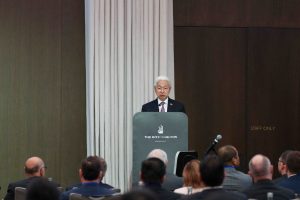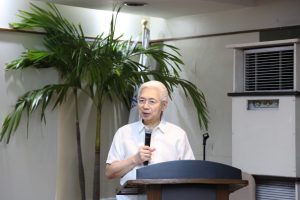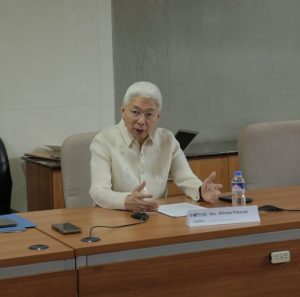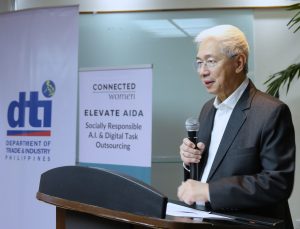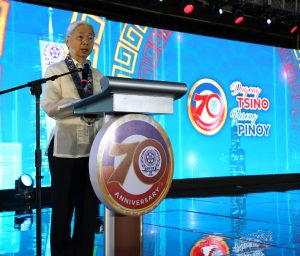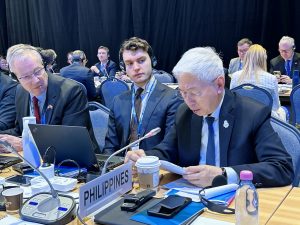01 February 2024 | Dusit Thani, Makati City
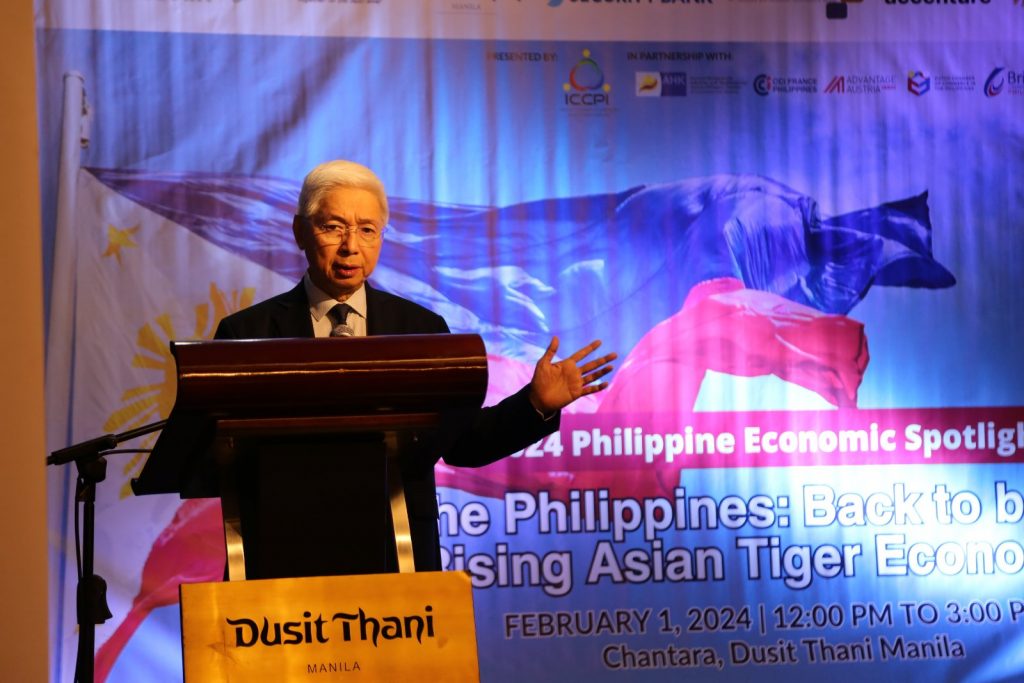
I just want to extend my greetings to all the participants. I will not greet our organizers and special guests, one by one. Thanks to the organizers, of course, the ICCPI.
Your collaboration fosters more robust ties between Italy and the Philippines, between European Union and European countries, in general promoting economic ties and cultural exchange.
The Philippines has a rich history of economic resilience and growth. In the past and we believe going into the future, we have been recognized as one of the fastest-growing economies in Asia, earning the title of the ‘Asian Tiger’ before and being expected to come back. That’s exactly the theme of our meeting today. With that, allow me to highlight some key areas where we focus efforts to aim for the status of the “Rising Asian Tiger Economy.”
The Marcos Jr. administration stands at the forefront of pioneering strategies to catalyze growth and attract global investment. Our approach is holistic, deliberate, and innovative.
THE ECONOMY
The Philippine economy grew by 5.6 percent in 2023 this last year, outpacing major economies in Asia, such as China (5.2 percent), Vietnam (5.0 percent), and Malaysia (3.8 percent) based on the latest available data. Notably, sectors such as financial and insurance activities saw a remarkable growth of
11.8 percent. At the same time, wholesale and retail trade, repair of vehicles and motorcycles, and construction also contributed significantly, with growth rates of
5.2 percent and 8.5 2 percent, respectively. This firmly establishes the country as one of the best-performing economies in the Asia-Pacific Region.
Our 5.6 percent GDP growth, however, fell short of the 7.6% growth that we achieved in 2022 and missed the 6% to 7% target: Reasons are high inflation and interest rates most of the past year dampened household spending power. Also, the ongoing global economic slowdown, which adversely affected our exports.
However, it is worth highlighting that our full-year GDP 2023 at 5.6 is 8.6
percent higher than the pre-pandemic level, which still I would say validates our strategies outlined in the Philippine Development Plan 2023- 2028.
We’ve witnessed a remarkable turnaround, with total investments accelerating at 11.2 percent, marking a significant shift from the 1.4 percent contractions we experienced in Q3. This resurgence in the 4th quarter has contributed to a commendable 5.4 percent growth in investment this year.
What’s particularly encouraging is the robust expansion we’ve seen in investment during the 4th quarter of last year, primarily fueled by a substantial increase in fixed capital, which soared by 10.2 percent. Of notable mention is the impressive growth in durable equipment, which surged by an impressive 14.6 percent.
These figures underscore our economy’s resilience and dynamism, reflecting businesses’ confidence and determination to invest and grow in the Philippines.
Foreign Direct Investment (FDI) has been pivotal in driving economic growth in general, also in the Philippines. In 2023, our lead Investment Promotion Agency, the Board of Investments (BOI), approved an impressive 1.26 trillion pesos (or USD 22.6 billion) worth of investments, achieving a 73 percent increase over 2022. Quite a significant job. On the other hand, our Philippine Export Development Authority (PEZA) approved PHP 176 billion (USD 3.1 billion) in investment approvals, up 25 percent over the previous year.
Labor market conditions have also remained favorable as the unemployment rate averaged 4.6 percent, at its lowest level in 18 years.
The country’s inflation for December 2023 further slowed down to 3.9 percent from 4.1 percent in November 2023, bringing the full-year average inflation rate to 6.0 percent. But on a downward trend.
Meanwhile, the country’s fiscal deficit stood at 1.02 trillion pesos as of October 2023, an 8.5 percent decline compared to the same period and time in 2022 and closer to our target levels.
The newly signed Ease of Paying Taxes Act, just signed earlier this month, I mean last month will modernize the Philippine tax administration. The law will encourage more taxpayers to enter into and comply with the tax system by streamlining processes and minimizing the burden on taxpayers, thereby increasing the country’s revenue collection that will address our fiscal deficit.
With the Philippines’ sustained economic recovery and improved fiscal position, it managed to maintain its investor-grade credit ratings amid downgrades in other economies, including the United States.
In August 2023, Rating and Investment Information (R&I) affirmed the country’s BBB+ rating and revised its outlook from stable to positive. In November 2023, both S&P Global and Fitch Ratings affirmed their BBB+ and BBB ratings, respectively with a Stable outlook.
In November 2023, S&P Global affirmed its “BB+’ long-term and ‘A2’ short- term sovereign credit ratings on the Philippines. According to S&P Global, its recent rating on the Philippines is based on a stable outlook on the country’s sustained economic recovery and decline in fiscal deficits expected over the next two years.
ECONOMIC OUTLOOK FOR 2024
What’s the outlook for 2024? While the Philippine economy performed well despite geopolitical challenges in 2023, we are rallying for an even better outlook this year.
Growth in 2024 will be driven by private consumption as inflation rate is expected to return within the low target range. Other factors like falling oil prices. This will be other drivers to our economic growth, the falling oil prices, robust public spending, greater investments lured by the country’s sound macroeconomic fundamentals, investment-grade credit ratings, and the implementation of structural reforms; and increased demand for Philippine exports as supply chain bottlenecks is resolved.
Meanwhile, a broad-based expansion in all major sectors of the economy led by services and industry is expected to drive growth on the supply side.
Strong Foreign Direct Investment and macroeconomic prospects make countries more attractive to investment, because that’s a platitude. Based on well-vetted empirical data, highly regarded consulting firm FDI Intelligence recently published an article that projected that the Philippines to be a “standout destination” for FDI in 2024. That’s FDI intelligence.
OPPORTUNITIES FOR INVESTORS/INVESTMENT PROSPECTS PER SECTOR
Okay, let me now talk about opportunities for investors, foreign and local, and investment prospects in the top sectors that we are prioritizing. Where are the slides? Hope you can see the slides on the screen presents our aspiration and industrial positioning strategy.
It is not only growth that we are after; industrial transformation is equally important, if not more important. We aspire to become the regional hub for smart and sustainable manufacturing and services. We are no longer competing based on cost. We cannot.
For one, we have challenges in interconnecting the islands in the Philippines, and therefore, logistics costs would be difficult to bring down 5 and could comparably be more expensive here than in other countries contiguous area. It is not unknown that in terms of power cost, we are one of the most expensive in Asia, but that’s in terms of fossil fuel-based and times are changing.
With the growing and urgent concerns to have zero, even negative carbon emissions, when multilateral agreements take effect or take the aspect of meeting ESG goals a significant consideration when customers and buyers of their products globally demand sustainable solutions, the Philippines is actually in an excellent situation where we can turn our disadvantages into advantages, positioning the country to be the regional hub for smart and sustainable manufacturing and services anchored on significant advantages:
1. Young and talented workforce: The Philippines is well known to have a large, talented workforce. We have the youngest in median age at 26 among all parties, participating in the Indo-Pacific Economic Framework (IPEF), including Indonesia, Thailand, and Vietnam.
Richness in relevant natural resources, both green minerals resources, and renewable energy resources: The country ranks second in the world for mineral reserves, with reserves of about 400 million metric tons; we are among the top ten in copper, with reserves of about 4 million metric tons; and we also have about 260,000 MT in cobalt reserves. These are the metals/minerals needed for batteries and for firing the transition for a green economy. We also have much bigger reserves in non-metallic mineral deposits.
The wealth of mineral resources provides opportunities in the green metals sector, including in the following activities:
· Exploration and development of additional mineral resources to build up the mineral base, 30% of our land area is determined to be mineral resourceful or mineral-rich areas
· Mineral processing to optimize the value of resources instead of direct shipping and minimal processing, because there are other investment opportunities, we are talking to European, American and Chinese processors of nickel ore
To illustrate, a big advantage of the Philippines’ mineral richness, I can share that China depends on the Philippines now for almost 90% of its nickel ore used for battery production. And China is the biggest source of batteries for electric vehicles and energy storage. The demand for these minerals, particularly nickel, can only increase as the world transitions to a more sustainable future. It is to the Philippines’ advantage therefore to process nickel locally, as Indonesia has done to produce battery precursors and, eventually, batteries.
We are really at the unfavorable side of the trade with China with respect to nickel.
The Philippines has abundant renewable energy (RE) resources. These are necessary for the global transition to clean energy technologies and applications.
Various studies estimate that the Philippines has almost 500 GigaWatts (GW) of renewable energy potential, including biomass, geothermal, hydro, ocean, solar, and wind. The World Bank has even identified a total potential capacity of 178 GW just for offshore wind.
We intend to tap this vast potential as we target to increase the share of renewables to our power generation mix from the current 22% to 50% by 2040. The total RE investment requirement is huge, placed at over USD 97 Billion.
I will indicate later on that most of the investment registrations in BOI are mostly with renewable energy, particularly offshore wind. And as I’ve said, there will be significant change. I don’t know whether it has already done so. There is a discussion on the border carbon adjustment tax that will also help product sign for the Philippines produce with renewable energy. And we’re competitive with countries that are still heavily dependent on fossil fuels.
One of our key aspirations is to establish the Philippines as a hub of electric vehicle (EV) manufacturing and assembly. Here are the advantages we offer:
1. The abundant supply of green metals, which can account for a significant portion of an EV’s cost. I understand that the amount is 40% or so of the vehicle cost.
2. Strength in electronics manufacturing, which is crucial for developing the supply chain of EV parts.
3. Skilled software developers capable of creating battery management systems and other software required for integrating the various functions of an EV.
4. Access to markets, including the sizeable domestic demand and the larger export markets. Just to foresee the shift modernization of jeepneys to eventually electric vehicles will be a major demand source for electric vehicles.
To further support the growth of the EV industry, the government has implemented several measures:
· Removal of the 30% MFN Tariff on Electric Vehicles to benefit countries with which the Philippines has no Free Trade Agreements (FTAs), such as the EU, UK, US, and Taiwan, as well as those covered by older FTAs.
· Excise tax reduction or elimination depends on the vehicle’s price, ranging from 4% to 50%, that’s the excise tax.
· Non-fiscal incentives under the Electric Vehicle Industry Development Act (EVIDA, 2022), including exceptions from vehicle volume reduction schemes, use of exclusive bus lanes, priority for parking, mandatory government purchase of EVs as a percentage of total procurement, and mandatory installation of charging stations in buildings and institutions.
Our next aspiration. The Philippines is a thriving hub for semiconductor manufacturing services (SMS) with strengths in assembly, test, and packaging, and in electronics manufacturing services (EMS), hosting the operations of foreign companies, there are about 1000 of them, foreign companies that serve both local and international clients and employing approximately 3.2 million direct and indirect workers.
For EMS, the Philippines is particularly strong in complex printed circuit board (PCB) assembly, box build, and systems assembly, with growing capabilities in design and development and original design manufacturing (ODM). In fact, I can cite that some companies came to the Philippines looking for manufacturing to avail of the low-cost production here and eventually found that the are engineers and professionals who can introduce their love for innovation and improve their products. So, in addition to production lines, they are now in R&D operations as well.
The country is also an emerging Integrated Circuit (IC) Design player. The country is poised to attract more investments and become a hub for high-value electronics manufacturing, chip design, and advanced product development.
One European company that you’re all familiar with is Dyson. It does a lot of R&D in the Philippines and produces its very expensive homecare products.
The electronics and semiconductor sectors significantly contribute to Philippine exports: 73% of firms are engaged in semiconductor manufacturing services (SMS).
We aim for the country to be recognized for its competitive IC design companies that can provide chip design services to the worldwide IC ecosystem. One company celebrated its 25th anniversary in the Philippines the other year. I attended their dinner; the CEO flew from the US saying they have 1000 design engineers here and only 100 in the other countries that are notable in IC design and also in Asia. I won’t name the country.
We aim for the country to be recognized as an IC design company that can provide cheap design services worldwide IC ecosystem. To support this goal, plans are underway to establish a Science and Technology Center, which will house an IC design training laboratory, an R&D lab, and a lab-scale wafer fab.
Just a lab-scale wafer hub so people can see the whole value chain of the semiconductor industry, with super demanding power. The presence of such a center will create more investment opportunities in electronics manufacturing, chip design, and original product design and development. It will pave the way for cutting- 9 edge products and technologies in various sectors, including healthcare, automotive, aerospace, and even autonomous vehicle batteries and smart wearables.
A US official announced recently, like two days ago, that the US is partnering with the Philippines and six other nations to diversify its semiconductor supply, per the CHIPS and Science Act. The Philippines, along with Vietnam, Panama, Puerto Rico, and Mexico, will receive funding from the US government to make the ecosystem of their local semiconductor industry more conducive to US investors.
The Philippines possesses a robust and steadily growing IT infrastructure, ready to complement international firms’ operations. We have a wide array of globally certified data centers; while other countries have already stopped the hosting of data centers due to power supply limitations. In addition to these numerous data centers, there are 13 cable landing stations; and 19 subsea cables, connecting the Philippines to other countries of which 14 are international cable systems.
We have opportunities in the Philippine agribusiness industry as well. Now, we go to food security. One of the major goals of many countries including the Philippines. While the country has established a strong global presence on essential export commodities, such as coco-based products, bananas and pineapples, carrageenan, and preserved tuna, we remain committed to modernizing these sectors. We are looking for partners and investors who can aid us in the production and value-adding activities through advanced agricultural technologies and modern logistics.
With the need to ensure food security for the country, the cold chain is vital in the agribusiness value chain. However, currently, only 60% of the agriculture or food products produced in the country pass through the needed cold chain facilities, resulting in spoilage of about 40% of agricultural produce. Investments are welcome in this sector.
Of course, we cannot exclude the very popular IT-BPM sector, which has always been a consistent priority for the Philippines. As you may be aware, the Philippines is a top-tier destination for IT-BPM services and remains one of the leaders in the global IT-BPM industry with a wide range of services. It also contributes around 9% of the Philippine GDP and employs about 1.7 trillion direct workers as of last count.
Creative Industries
The next sector is coming out of government support. Let me now talk a bit about the recently enacted Philippine Creative Industries Development Act (PCIDA), which aims to foster the growth of the creative industries by blending cultural heritage and talent with technology and business. It focuses on creating distinctive Filipino content, fostering innovation through digital upskilling, and building a business infrastructure to support creative entrepreneurs. The creative industries also include digital interactive media. The creative industries also include digital interactive media, so there is a linkage with the other big priority in the digital space.
National Innovation Gateway
Okay, another important initiative to support all our thrust, the industrial positioning of what I’m talking about is the establishment of the National Innovation Gateway. To promote innovation and commercialization of research, we are building a National Innovation Gateway to house our Center AI Research (CAIR), Industry 4.0 Pilot Factory (I4PF), SME AI Academy, and startup incubation and acceleration facility. To bridge gaps in our innovation and entrepreneurship ecosystem, we are collaborating with four (4) premier universities in the Philippines, two in Luzon, one in Visayas, and one in Mindanao as we build Science and Technology Parks.
These initiatives are expected to drive technological advancement, economic growth, and societal progress, positioning the Philippines as a critical player in the global innovation arena.
Geographic Location
Regarding our geographic location, we have found out in our countless discussions with investors in China and all over the region that 11 previously, some countries in Southeast Asia benefitted from China’s strong growth. This has driven investments in these countries, particularly Vietnam, due to its proximity to China.
But, in the current context, where there is slower China growth and a geopolitical situation that has encouraged re-shoring, friend-shoring, or de- risking, companies from Taiwan, Japan, and South Korea are trying to re-shore manufacturing back into their countries or to the neighboring ASEAN countries like the Philippines. The drivers we are seeing to drive the Philippine economy now are our country’s proximity to Southeast Asia and to the major US markets. We could be a potential beneficiary of this global development. This is where the Philippines’ place has a very distinct advantage.
Given its strategic location in Asia, the Philippines could be a platform for companies to access the 690 million-strong Southeast Asian consumer market. Our proximity to these growing economies can allow it to enter other supply chains and be part of inter-country economic systems. This creates more opportunities for collaboration and partnership.
INTERNATIONAL ENGAGEMENTS
Let me now talk about international engagements. The DTI is working on enhancing market access for the country’s exporters through free trade agreements (FTAs) and increasing the global mindshare of Philippine products and brands by expanding and diversifying the country’s exports and destinations.
With the continuous collaboration of DTI, our nation enjoys access to various markets, including the ASEAN market, the Regional Comprehensive Economic Partnership (RCEP), and the Philippines-Japan Economic Partnership Agreement (PJEPA), among others. These agreements underscore our commitment to fostering economic growth and international cooperation.
With RCEP, investors can access markets in other RCEP countries by manufacturing and exporting their products from the Philippines.
If you are following developments in the Philippines, the EU Commission President last year announced the launch of Philippines-EU FTA negotiations last year. In this regard, the Philippines, EU, DTI, and my counterpart have just concluded the stocktaking exercise preparatory to the resumption of FTA negotiations. Note that an FTA with the EU is crucial to us. As we become an upper middle-income country within the next few years, we will lose our GSP+ eligibility, and we need an FTA to maintain our preferential access to the EU market for our exports.
In addition, the Philippines-South Korea FTA has already been signed and will be implemented early this year.
KEY REFORMS TO PROMOTE TRADE AND INVESTMENTS
Now, I’ll go to some key reforms to promote trade and investments, some of which you may know very well. But in a way of review, I’ll go with it quickly.
The leadership under President Marcos is dedicated to enhancing the business environment and fostering a more favorable climate for business operations, as evidenced by the implementation of the following reforms, some from the previous administration but implemented this time:
1. Corporate Recovery and Tax Incentives for Enterprises Law (CREATE) allows the government to grant fiscal and non-fiscal incentives for high-value strategic investments.
The CREATE Act is undergoing amendment in our legislature to address certain infirmities under the current version of the law.
2. Liberalization of the Implementing Rules and Regulations of the Renewable Energy (RE) Act hastens the transition to RE resources by allowing 100% foreign ownership of projects engaging in exploration, development, and utilization of solar, wind, hydro, and tidal energy.
Further, to promote energy efficiency through renewable energy, we instituted a new policy that is in effect right now, providing subsidies for up to 50% of the investment cost of a RE project of a company that will transition from fossil fuel-based electricity to put up its own renewable energy facility to power its own operation.
3. Executive Order (EO) No. 18 establishes the Green Lanes for Strategic Investments that will expedite the investment processes through simultaneous action in government. It will ease the “barriers” across multiple regulatory agencies that hamper realizing nationally significant or highly desirable projects.
But the long-term solution is digitalization which is now going down to local government units. Just an update on the Greenlane Projects: The Board of Investments has so far registered thirty-seven (37) projects with a total
investment value of PhP 1.2 trillion. The proposed investments include renewable energy, common telecom towers, hyperscale data centers, and manufacturing.
There are several others in the pipeline.
4. The amended Public Service Act (PSA) allows up to 100 percent foreign ownership of public services in telecommunications, shipping, air carriers, railways, subways, airports, and toll roads. This will encourage more foreign investments and innovation to lower prices and improve the quality of goods and services.
5. The amended Foreign Investments Act (FIA) has made the Philippines an attractive destination for startup firms, with minimal capital for foreign companies involved in advanced technology, with a reduced capital requirement and workforce size.
6. The amended Retail Trade Liberalization Act has lowered the minimum paid-up capital required for retail investments. It might have contributed to increasing investments in the sector, allowing expansion and enhancing competition, which translated into the sector’s increase in revenues and value in the country.
7. The newly signed Ease of Paying Taxes Act which will modernize the Philippine tax administration through simplified tax filings and strengthen taxpayer rights to encourage and improve tax compliance, which could lead to more investments for the country.
I assure you that the Philippine government is fully committed to supporting and facilitating your business endeavors in our country. We extend our hand in partnership and stand ready to provide any assistance you may require as you navigate the business landscape in the Philippines.
CONCLUSION
Ladies and Gentlemen, the road ahead is complex and demands a multifaceted strategy. It requires policy reform, strategic investment, and unwavering international cooperation. By acknowledging and proactively addressing our challenges, the Philippines will advance toward sustainable growth and resilient development.
With the collective efforts of the government, the private sector, both local and foreign, and the Filipino people, I am confident that we will emerge as a premier investment hub in the region and return to being the rising Asian Tiger Economy.
Thank you, and a pleasant afternoon to everyone! ♦
Date of release: 01 February 2024



